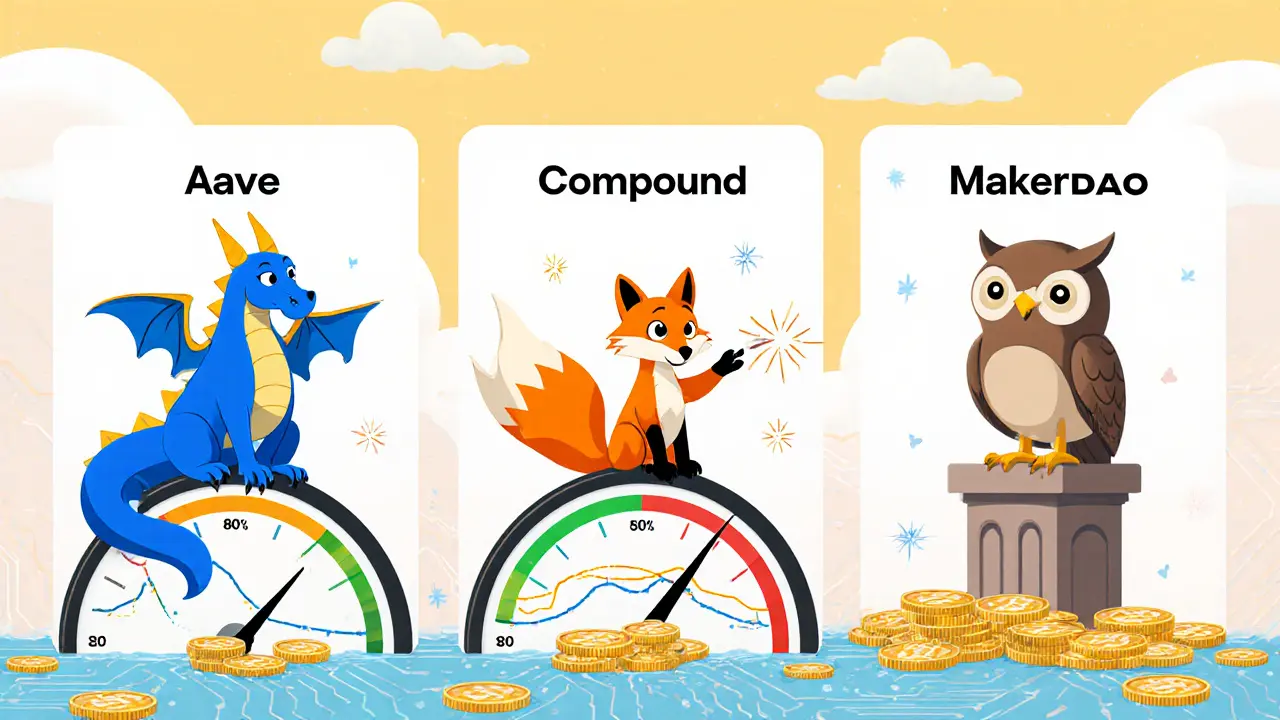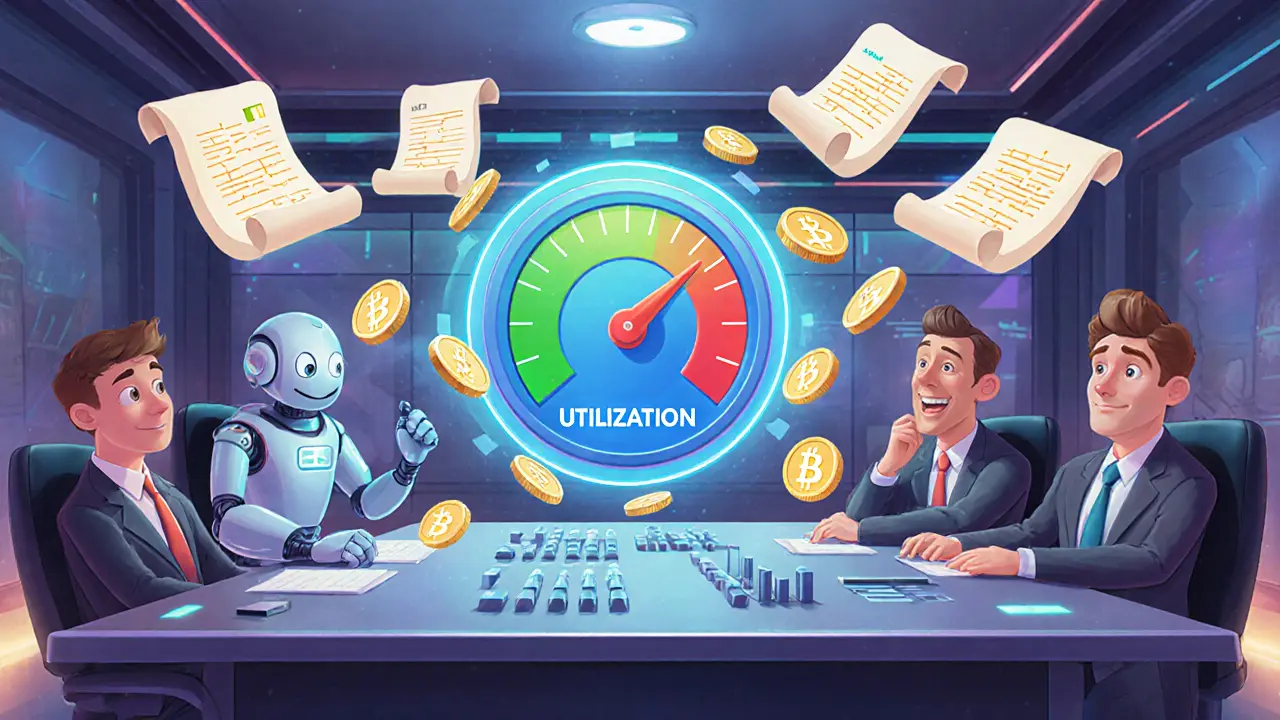DeFi Interest Rate Simulator
How Interest Rates Change with Utilization
See how utilization impacts borrowing and lending rates using different model types. The kink point represents the threshold where rates begin rising more steeply.
Trying to figure out why your DeFi loan rates jump from 5% to 50% overnight? The answer lies in the algorithmic interest rate models that power every major lending protocol. These models replace bank committees with smart‑contract math, automatically tweaking borrowing and lending rates based on how much capital is sitting idle versus how much is being pulled out as loans. Understanding how they work, where they differ across platforms, and what you can do to stay ahead is essential for anyone who wants to earn reliable yields or avoid painful liquidations.
Below you’ll get a plain‑English rundown of the three main model families, a side‑by‑side look at the biggest players (Aave, Compound, MakerDAO), and a checklist you can follow before you lock any assets into a loan.
What exactly is an interest rate model in DeFi?
Interest rate models in DeFi lending are algorithmic frameworks that automatically set borrowing and supply rates for digital assets without a central bank. They rely on transparent smart contracts that read on‑chain data, such as the amount of funds supplied versus the amount borrowed, and then calculate rates based on predefined mathematical formulas. The goal is simple: keep the market liquid enough that lenders can withdraw their funds while borrowers still find cheap capital.
Key concepts that drive every model
- Utilization (U = borrowed assets ÷ total supplied assets) is the core metric. High utilization means most of the pool is loaned out, prompting higher rates to attract more supply.
- Kinked interest rate model adds a breakpoint (the "kink") where the slope of the rate curve sharply increases, encouraging lenders to add liquidity once utilization passes a target level.
- Stable vs. variable rates let borrowers choose between a predictable interest schedule or a market‑driven one that can swing with utilization.
- Loan‑to‑value (LTV) determines how much you can borrow against a given collateral, directly affecting risk and liquidation thresholds.
Three families of rate models
- Linear models: Rate rises in a straight line with utilization. Simple but can lead to extreme rates when utilization approaches 100%.
- Non‑linear models: Use exponential or polynomial curves to smooth the increase, reducing spikes but adding complexity.
- Kinked (piecewise linear) models: The most common in 2025. Up to a preset optimal utilization (usually 80‑95%) the rate climbs gently; beyond that point the slope becomes much steeper, creating a strong incentive for users to supply more capital or repay loans.
All three families share the same purpose-prevent 100% utilization, which would lock lenders out of their own funds and trigger liquidity crises.
How the biggest protocols implement these models
Below is a snapshot of how Aave, Compound, and MakerDAO set rates for the most actively used stablecoin, USDC, as of October 2025.
| Platform | Supply APY | Borrow APR | Optimal Utilization | Max LTV | Rate Model |
|---|---|---|---|---|---|
| Aave | 7.47% | 8.94% | 80‑95% | 80% | Kinked (piecewise linear) |
| Compound | 8.30% | 4.10% | 75‑90% | 75% | Kinked with dynamic adjustment (V3) |
| MakerDAO | 11.5% (DSR) | 12.5% (DAI borrow) | Not utilization‑based (fixed DSR) | 66‑75% (vault‑specific) | Fixed savings rate / collateral‑risk model |

Why utilization matters for you
When utilization climbs above the kink point, borrowing rates can double or triple in minutes. For example, during the March2020 crash Aave’s USDC borrow APR spiked past 50% because the pool went from 80% to 98% utilization within hours. Lenders see their APY drop as the protocol redirects more of the accrued interest to borrowers to attract fresh supply.
Conversely, in a low‑utilization environment (below 40%) rates shrink dramatically, sometimes below 1%, which can make a pool unattractive for lenders but cheap for borrowers.
Understanding where a pool sits relative to its optimal range helps you decide whether to supply, borrow, or move assets to a protocol with smoother rates.
Practical checklist before engaging with a DeFi loan
- Verify the current utilization ratio on the platform’s dashboard (most interfaces display a percentage gauge).
- Identify the optimal utilization range for the asset you’re targeting; stay below the kink if you prefer stable rates.
- Check the protocol’s max LTV for your collateral-higher LTV means more borrowing power but also higher liquidation risk.
- Confirm whether the platform offers stable rate options; these lock the borrow rate for a set period (typically 30‑90days) and can protect you during volatility.
- Calculate estimated gas costs for supply/borrow/repay actions; during network congestion fees can eat a noticeable chunk of your yield.
- Read the latest governance proposals-rate‑model tweaks (like Compound V3’s dynamic kink) can shift the profitability landscape overnight.
Advanced tactics: arbitrage and rate smoothing
Experienced users exploit differences between platforms. If Aave’s USDC supply APY is 7.5% while Compound offers 8.3%, you can supply to Compound, borrow USDC from Aave at a lower rate (if its variable rate is below 7%), then swap the borrowed assets back to Compound. The net spread becomes your profit after gas.
Newer protocols (e.g., Aave V4) are adding rate smoothing algorithms that dampen spikes around the kink. They work by averaging utilization over short windows (5‑15 minutes) before applying the rate curve, which reduces abrupt jumps but may delay incentives for new liquidity.
When planning an arbitrage loop, factor in:
- Current utilization on each pool.
- Projected gas fees for the next 2‑3 transactions.
- Potential slippage on token swaps, especially when moving large amounts.
- Risk of liquidation if the borrowed asset’s price drops while you’re still in the loop.
Regulatory outlook and future trends
European MiCA rules are set to require clear disclosure of algorithmic rate parameters, which could push protocols to publish their kink points and slope coefficients on‑chain. In the US, the SEC’s focus remains on token classification, so most DeFi rate models stay under the radar.
Looking ahead, AI‑driven models are expected to appear by 2026, dynamically adjusting the kink based on real‑time volatility and predicted inflows. Early trials on testnets already show a 15% reduction in rate volatility without sacrificing liquidity.

Common pitfalls and how to avoid them
- Rate shock liquidation: If utilization spikes, your borrow APR can surge, raising your debt’s value in native terms. Keep a buffer in your health factor (aim for >1.5) to survive spikes.
- Ignoring governance changes: A sudden proposal to lower the optimal utilization can instantly raise rates. Subscribe to protocol’s governance forums.
- Over‑paying gas: Chasing high‑frequency rate changes on congested networks can erode profits. Use layer‑2 solutions where supported (e.g., Aave on Polygon).
- Relying on a single asset: Diversify across multiple stablecoins or vault types to smooth returns.
Next steps for beginners
- Open a wallet (Metamask or Coinbase Wallet) and connect to the Aave or Compound UI.
- Supply a modest amount of USDC (e.g., $100) and check the displayed utilization.
- Watch the borrow APR for 48hours; note how it moves as utilization changes.
- If the APR stays within your comfort zone (<10%), try borrowing a small amount and repay within a week to test liquidation mechanics.
- Gradually increase exposure as you become comfortable reading the utilization gauge and health factor.
Conclusion
Interest rate models are the beating heart of DeFi lending. By mastering utilization metrics, understanding each protocol’s kink point, and keeping an eye on governance updates, you can turn these algorithms from a source of surprise into a predictable tool for earning yields or borrowing cheap capital. Whether you’re a casual saver, a yield farmer, or a developer building the next protocol, the concepts covered here give you the foundation to navigate the ever‑evolving DeFi rate landscape.
Frequently Asked Questions
What is utilization in DeFi lending?
Utilization is the ratio of borrowed assets to the total assets supplied in a lending pool. It is expressed as a percentage and directly influences the interest rates set by the protocol’s algorithm.
Why do rates spike after the kink point?
The kink point marks the optimal utilization range. Beyond it, the model steepens the slope of the rate curve to quickly raise borrowing costs, which incentivizes lenders to add more capital and borrowers to repay, preventing the pool from hitting 100% utilization.
How can I protect myself from liquidation during high‑rate spikes?
Maintain a health factor well above 1 (ideally above 1.5), keep a buffer of collateral, and monitor utilization dashboards. If rates start climbing, consider repaying part of the loan or adding more collateral before the health factor drops too low.
Are stable rate options safe from market volatility?
Stable rates lock the borrow rate for a fixed term (usually 30‑90days). They protect you from sudden rate spikes but can be slightly higher than variable rates during low utilization periods. Choose them if you value predictability over maximum yield.
What’s the difference between Aave’s and Compound’s kink models?
Both use piecewise linear curves, but Aave’s kink is fixed around 80‑95% utilization, while Compound V3 introduces a dynamic kink that adjusts based on recent volatility data. This makes Compound’s rates slightly more responsive to market changes.


Melanie Birt
October 13, 2025 AT 01:05Hey folks, if you’re diving into DeFi lending rates, start by checking the current utilization gauge on the dashboard – it’s the single most telling metric. The higher the utilization, the steeper the borrow APR climbs, especially past the kink point. Most protocols, like Aave and Compound, keep optimal utilization between 80‑95% to balance supply incentives. If you see the pool hovering around 70%, you’re in a sweet spot for low‑cost borrowing, but supply APY might be modest. Always keep a buffer in your health factor (aim for >1.5) so a sudden utilization spike doesn’t wipe you out 😅. Also, remember to factor in gas fees; on Ethereum they can easily eat a few percent of your yield.
Stay vigilant and happy farming!
Lady Celeste
October 13, 2025 AT 17:45Wow, another boring guide about rates – snooze.
Ethan Chambers
October 14, 2025 AT 10:25Honestly, all this hype about “kinked” models is just marketing fluff; the real profit comes from arbitrage between stablecoin pools, not from fiddling with utilization curves.
Carol Fisher
October 15, 2025 AT 03:05It’s disgraceful how some “decentralized” platforms ignore the ordinary user’s safety, chasing profit while risking total loss – we need stricter ethics in DeFi! 🇺🇸💥
gayle Smith
October 15, 2025 AT 19:45Let’s dissect the cap‑ex dynamics: when the liquidity‑supply derivative hits the non‑linear inflection, the emergent volatility vector destabilizes the collateral‑ratio, creating a cascade of liquidation cascades – pure chaos!
mark noopa
October 16, 2025 AT 12:25Alright, let’s unpack this whole interest‑rate model thing from a philosophical angle. First, consider that every algorithmic curve is a mirror of collective human behavior, a social contract encoded in Solidity. When utilization climbs, the protocol penalizes borrowers, rewarding lenders – a classic Hobbesian lock‑down of scarcity. But the twist is that these contracts lack any moral compass; they simply follow code, indifferent to our panic when rates spike. That’s why you ought to always maintain a safety buffer, not just a health factor, but an extra cushion of liquid assets sitting idle. Think of it as an insurance premium you pay to the system for the privilege of borrowing. Moreover, the kink point isn’t a mystical constant; it’s a parameter set by governance, often tweaked behind the scenes in obscure proposals. If the DAO decides to shift the kink from 85% to 70%, you’ll see a sudden jump in APR overnight, and many unwary users get liquidated. This is why reading governance forums is as essential as watching the utilization gauge. Also, gas fees on Ethereum can be astronomical during high‑demand periods, which effectively raises your borrowing cost far beyond the quoted APR. Some savvy users migrate to layer‑2 solutions like Polygon, where the same model runs with negligible fees, preserving yields. Another nuance is the difference between stable‑rate and variable‑rate options; stable rates lock you in, but often at a premium, while variable rates can be cheap until the next utilization surge. Don’t forget that many platforms now employ rate‑smoothing algorithms that average utilization over a short window, which reduces abrupt jumps but also delays the incentive signals that attract new liquidity. Finally, always diversify across multiple protocols – Aave, Compound, and even newer entrants – because no single model can guarantee optimal returns in every market condition. In sum, treat the interest‑rate model as a living organism: observe, adapt, and never put all your eggs in one smart contract basket.
Rama Julianto
October 17, 2025 AT 05:05Great deep dive! Just a quick heads‑up: if you’re using the smoothing feature, watch the time‑window settings – a too‑short window can cause oscillations that look like “rate shock” but are just artifacts.
Helen Fitzgerald
October 17, 2025 AT 21:45Hey everyone, if you’re just starting, my tip is to begin with a small $100 USDC supply on Aave, monitor the utilization graph for a day, then decide if you want to scale up. It’s a low‑risk way to get the feel for how rates respond.
Jon Asher
October 18, 2025 AT 14:25Exactly, and setting an alarm for utilization crossing 80% can save you from surprise spikes.
Scott Hall
October 19, 2025 AT 07:05From my perch, I’ve noticed that during quiet market periods the borrow rates drop below 1%, which is perfect for short‑term borrowing to leverage a quick arbitrage.
Laura Myers
October 19, 2025 AT 23:45OMG, the moment the kink hits, it’s like watching a rollercoaster – heart racing, palms sweating, and the APR screaming “50%!” 🎢
Sanjay Lago
October 20, 2025 AT 16:25Honestly, the guide is solid, but don’t forget to also check the token’s oracle health – a bad price feed can mess up the LTV calculations.
arnab nath
October 21, 2025 AT 09:05They don’t tell you that the “transparent” rate formulas are just a front for hidden manipulations by the core devs.
Nathan Van Myall
October 22, 2025 AT 01:45One thing to keep an eye on is the real‑time gas price; even a modest APR can be nullified by high transaction costs.
debby martha
October 22, 2025 AT 18:25Not bad, but the article could’ve been shorter.
Ted Lucas
October 23, 2025 AT 11:05Yo fam, if you want to juice those yields, stack up on the kinked pools when utilization is low – it’s pure profit magic! 🚀💰
ചഞ്ചൽ അനസൂയ
October 24, 2025 AT 03:45Think of the rate model as a garden: you plant liquidity seeds, tend them with proper timing, and watch them bloom when the market conditions are right.
Philip Smart
October 24, 2025 AT 20:25Actually, the whole “optimal utilization” thing is overblown; you can earn more by hopping between platforms based on short‑term rate differentials.
Jacob Moore
October 25, 2025 AT 13:05Friendly reminder: always double‑check the contract address before interacting – phishing scams are rampant.
Manas Patil
October 26, 2025 AT 04:45From a cultural perspective, the community’s embrace of dynamic rate models shows a shift towards algorithmic governance, which is fascinating.
Annie McCullough
October 26, 2025 AT 21:25i think the whole hype around kinked models is just a marketing ploy its not that deep
Ben Parker
October 27, 2025 AT 14:05Yo! Don't ignore the new 👀 rate‑smoothing updates – they can keep your APR from exploding! 🌟
Daron Stenvold
October 28, 2025 AT 06:45Dear community, I empathize with the stress caused by sudden rate spikes; let us strive for more transparent governance to mitigate such shocks.
hrishchika Kumar
October 28, 2025 AT 23:25Celebrating the vibrant tapestry of DeFi, where every protocol adds a unique hue to the financial canvas, enriching our shared ecosystem.
Nina Hall
October 29, 2025 AT 16:05Keep experimenting, stay curious, and remember that every small win builds the path to bigger financial freedom!